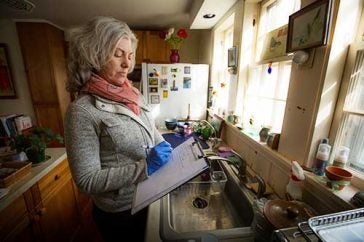
As states across the country move to regulate PFAS contaminants in public water supplies, Laurel Schaider worries about another source of drinking water that is often overlooked: private wells. Approximately 44 million people in the United States rely on them for their drinking water. However, unlike public wells, private wells are not regulated under the US Environmental Protection Agency’s Safe Drinking Water Act.
“It’s up to well owners to regularly test their water for contaminants, and even if they do, they might not know or be able to test for PFAS,” says Schaider, an environmental chemist at Silent Spring Institute. Schaider, along with University of Rhode Island (URI) water quality coordinator Alyson McCann, co-leads STEEP’s Community Engagement Core. Together, they have developed a private well testing program on Cape Cod. The goal is not only to learn about the prevalence of PFAS in private wells (20 percent of Cape residents own a private well), but also to engage the community in understanding—and reducing—their exposures.
So far, about 100 residents in twelve towns across the Cape have had their well water tested through the program. The samples are sent to STEEP investigator Elsie Sunderland at Harvard University for analysis. Participants each receive a personalized web-based report, developed by Silent Spring, that describes their water test results—what contaminants were found, how their levels compare with others on the Cape, and whether their levels exceed any drinking water guidelines. The report also includes information on PFAS and their health effects, as well as tips for protecting well water from contamination.

“It’s a great way to engage the community,” says Cheryl Osimo, Executive Director of the Massachusetts Breast Cancer Coalition, one of the project’s community partners. When the researchers collect water samples, they talk to the participants and listen to their concerns. After the participants receive their reports, many follow up with questions. “Not only do they walk away feeling more informed and empowered to take action to protect their health, they’ve also helped contribute to science,” says Osimo.
In October 2019, at the second annual STEEP Science Day, the team presented preliminary findings from the project to the Cape community—study participants, students, government representatives, and local organizations all gathered to hear the update. ”So far, we’ve found PFAS in about 46 percent of the wells we tested,” says URI’s McCann. “Although none of the wells exceeded current federal or state guidelines, about three percent of wells had levels above the new proposed Massachusetts drinking water standard of 20 ng/L for the sum of six specific PFAS.”
The STEEP team also discovered that wells with higher levels of nitrate had higher levels of PFAS. The presence of nitrate suggests the contaminants came from nearby septic systems. About 85 percent of residents on the Cape have a septic system for treating household wastewater.
“In high density areas on the Cape where you have a large number of homes with their own septic systems, these systems are a likely source of PFAS contaminants in the groundwater,” says Schaider. That becomes a problem when residents also rely on private, shallow groundwater wells for their drinking water, she says.
Thankfully, there are steps people can take to reduce the risk of contamination. For instance, avoiding household products made with PFAS by switching to safer alternatives can help keep these chemicals from entering our wastewater, says Schaider. In densely developed areas with lots of private wells, municipalities should consider hooking residents up to a public water supply instead.
For the next phase of the study, she and her colleagues plan to conduct a land use analysis to explore other potential sources of PFAS contamination, such as wastewater from businesses like car washes and runoff from landfills. The team also plans to test an additional 150 wells on the Cape.
“The Cape community has been so supportive and engaged in this project,” says Schaider. “We’re extremely grateful for their participation, and we really couldn’t do this without them.”

